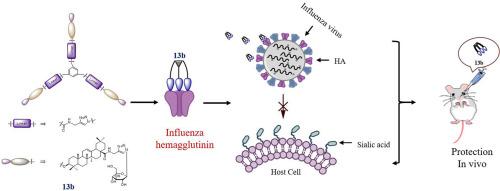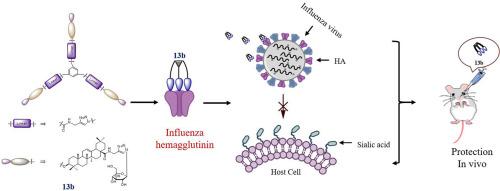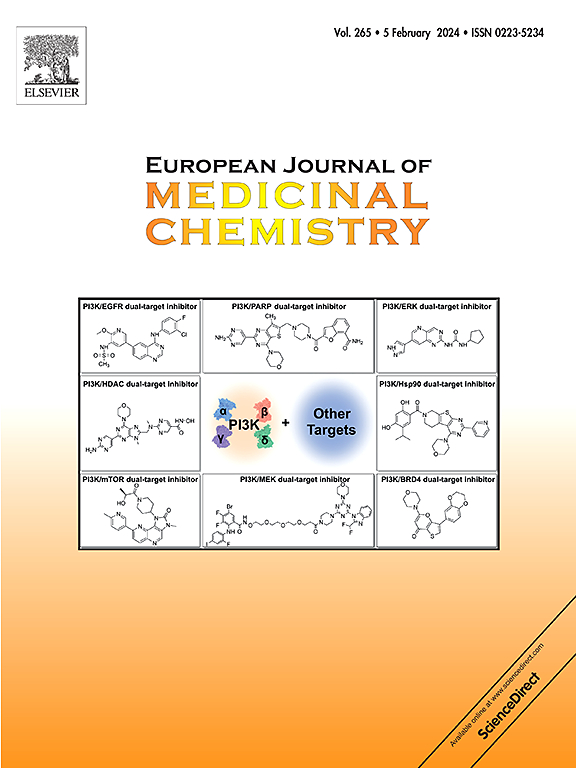Trivalent oleanolic acid-glucose conjugates: Synthesis and efficacy against Influenza A virus
IF 6
2区 医学
Q1 CHEMISTRY, MEDICINAL
引用次数: 0
Abstract
Influenza A virus (IAV) leads to significant morbidity and mortality due to the seasonal epidemics and spread. We have demonstrated that oleanolic acid (OA) C28 glucose conjugates and OA trimers are capable of effectively blocking the recognition and interaction between the influenza virus and host cells. In this study, a series of OA-glucose trimers were designed and synthesized through the CuAAC reaction. All trimers underwent screening for anti-IAV activities in vitro. Among these, compounds 13a and 13b showed inhibitory activity against the influenza virus, with IC50 values of 0.68 μM and 0.47 μM, respectively, demonstrating greater potency than oseltamivir (IC50 = 1.36 μM). Results from the time-of-addition experiment and hemagglutination inhibition assay suggest that these OA-glucose trimers may disrupt the recognition between the HA protein of IAV and sialic acid receptors on host cells, thus blocking viral entry. Furthermore, it was found that compound 13b effectively inhibits IAV infection in BALB/c mice. This study has elucidated the structure-activity relationships of OA trimers against the influenza virus and highlighted the utility of multivalent OA conjugates for enhancing ligand-target interactions in anti-influenza virus drug design, laying a groundwork for future research into the antiviral applications of these natural products.


三价齐墩果酸-葡萄糖共轭物:合成与抗甲型流感病毒的功效
甲型流感病毒(IAV)因季节性流行和传播而导致严重的发病率和死亡率。我们已经证明,齐墩果酸(OA)C28 葡萄糖共轭物和 OA 三聚体能够有效阻断流感病毒与宿主细胞之间的识别和相互作用。本研究通过 CuAAC 反应设计并合成了一系列 OA-葡萄糖三聚体。所有三聚体都进行了体外抗流感病毒活性筛选。其中,化合物 13a 和 13b 对流感病毒具有抑制活性,IC50 值分别为 0.68 μM 和 0.47 μM,显示出比奥司他韦(IC50 = 1.36 μM)更强的效力。添加时间实验和血凝抑制实验的结果表明,这些 OA-葡萄糖三聚体可能会破坏 IAV 的 HA 蛋白与宿主细胞上的唾液酸受体之间的识别,从而阻止病毒进入。此外,研究还发现化合物 13b 能有效抑制 IAV 在 BALB/c 小鼠体内的感染。这项研究阐明了 OA 三聚体抗流感病毒的结构-活性关系,突出了多价 OA 共轭物在抗流感病毒药物设计中增强配体-靶标相互作用的作用,为今后研究这些天然产物的抗病毒应用奠定了基础。
本文章由计算机程序翻译,如有差异,请以英文原文为准。
求助全文
约1分钟内获得全文
求助全文
来源期刊
CiteScore
11.70
自引率
9.00%
发文量
863
审稿时长
29 days
期刊介绍:
The European Journal of Medicinal Chemistry is a global journal that publishes studies on all aspects of medicinal chemistry. It provides a medium for publication of original papers and also welcomes critical review papers.
A typical paper would report on the organic synthesis, characterization and pharmacological evaluation of compounds. Other topics of interest are drug design, QSAR, molecular modeling, drug-receptor interactions, molecular aspects of drug metabolism, prodrug synthesis and drug targeting. The journal expects manuscripts to present the rational for a study, provide insight into the design of compounds or understanding of mechanism, or clarify the targets.

 求助内容:
求助内容: 应助结果提醒方式:
应助结果提醒方式:


